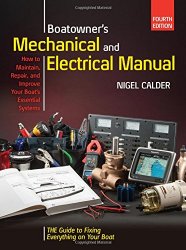I recently bought a 44 Marine Trader that I've been livingaboard on the hook for a couple weeks. The boat was already pretty well setup for being away from the dock:
-500 watts of solar on top of sundeck
-Trace C40 Charge controller
-Xantrex Freedom Marine 10 Inverter/Charger (1000 watt / 50 amp)
-Link 2000 Inverter controller panel
-Westerbeke 7.6kw generator
-The battery bank configuration is something I'm still trying to understand. It's equipped with: four 6-volt golf cart batteries + one 8D battery + two 12 volt AGMs up front for bow thruster. They seem to be wired oddly because I can't seem to isolate voltages between the banks on my DC panel gauge. Even if I switch to just #1 or just #2 they borh seem to decharge evenly. Also I've determind that the Port engine starts off bank #1 & Starboard off #2. Genset starts off either.
My questions:
1. Whats the lowest voltage i should allow the batteries to reach before kicking on the generator?
2. I've read that generators are inefficient at topping off the last % of a battery. And that's where solar is ideal. So at how many volts is the max that i should bother running the gen?
3. I've read that it's important to not run a generator at too small of a load. How do I determine what that load is?
4. I have room on my flybridge hardtop for 1000 watts more of solar. Would the rest of my current components be able to properly handle that increase -- or even just 500 more watts -- or would i need to upgrade inverters & controllers too?
5. Is it important to get the batteries back to 14 volts regularly? Or is 12.5 - 13.5 ok?
-500 watts of solar on top of sundeck
-Trace C40 Charge controller
-Xantrex Freedom Marine 10 Inverter/Charger (1000 watt / 50 amp)
-Link 2000 Inverter controller panel
-Westerbeke 7.6kw generator
-The battery bank configuration is something I'm still trying to understand. It's equipped with: four 6-volt golf cart batteries + one 8D battery + two 12 volt AGMs up front for bow thruster. They seem to be wired oddly because I can't seem to isolate voltages between the banks on my DC panel gauge. Even if I switch to just #1 or just #2 they borh seem to decharge evenly. Also I've determind that the Port engine starts off bank #1 & Starboard off #2. Genset starts off either.
My questions:
1. Whats the lowest voltage i should allow the batteries to reach before kicking on the generator?
2. I've read that generators are inefficient at topping off the last % of a battery. And that's where solar is ideal. So at how many volts is the max that i should bother running the gen?
3. I've read that it's important to not run a generator at too small of a load. How do I determine what that load is?
4. I have room on my flybridge hardtop for 1000 watts more of solar. Would the rest of my current components be able to properly handle that increase -- or even just 500 more watts -- or would i need to upgrade inverters & controllers too?
5. Is it important to get the batteries back to 14 volts regularly? Or is 12.5 - 13.5 ok?
Last edited:




